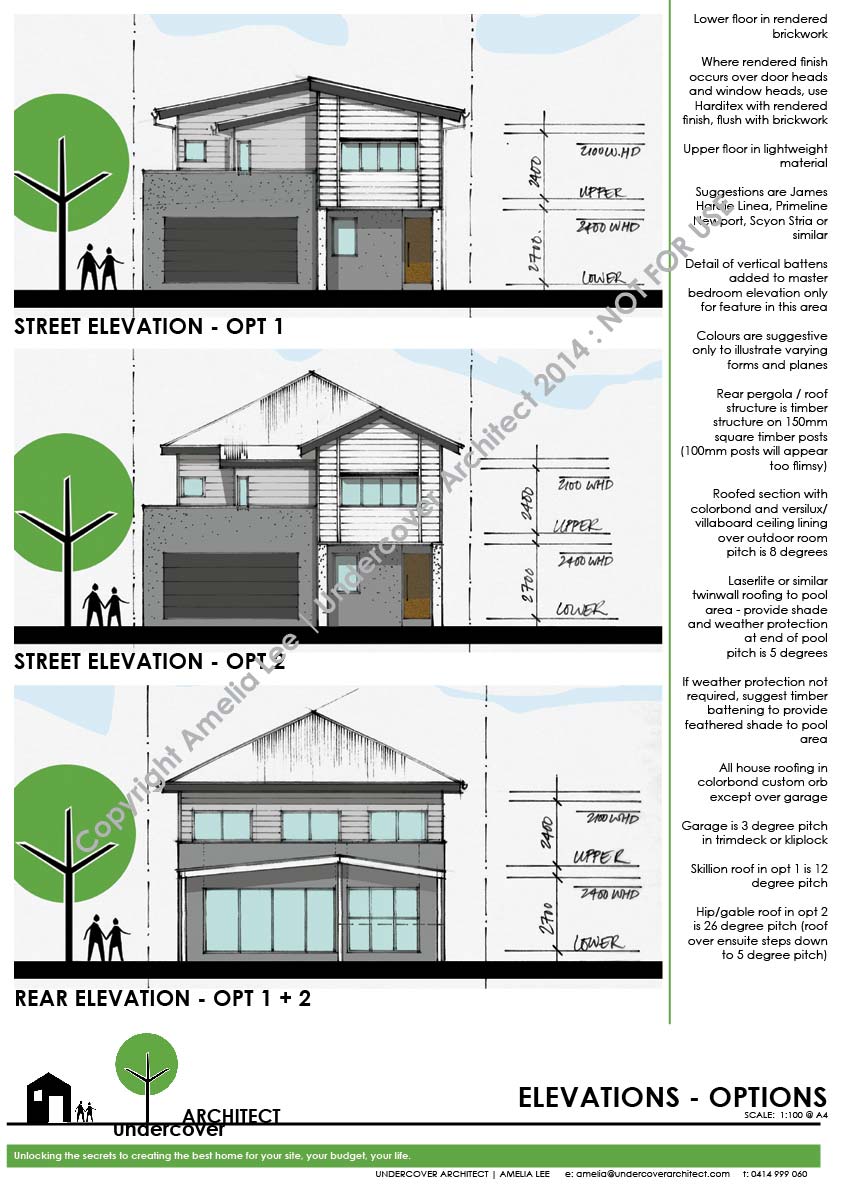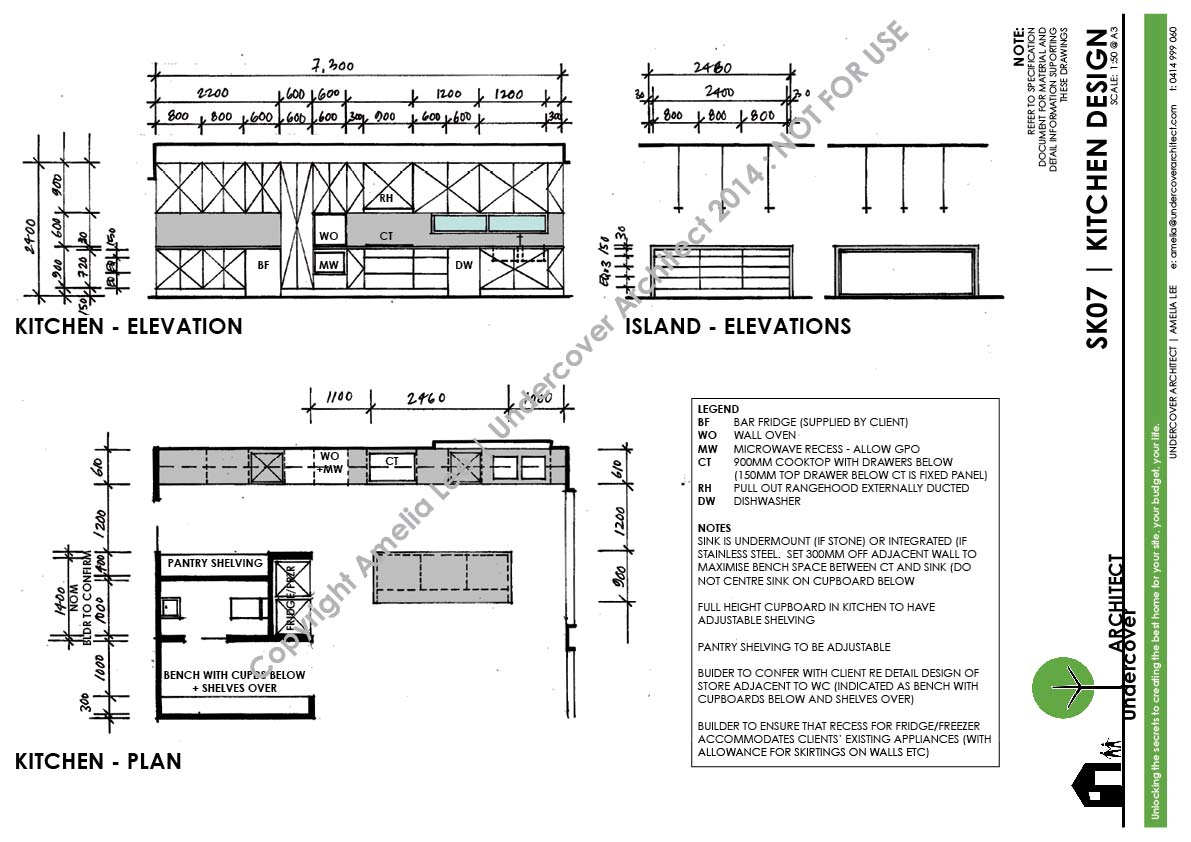
So what will the Andersons’ home cost to build? We find out in this latest instalment of their Project Diary.
The floor plan design is done. Let’s see how this home will look from the outside, and what it will cost to build …
In our last instalment, we spoke about the design process and achieving sign-off of floor plans that Clare and Darren were happy with. It was a fairly quick process, all managed remotely between Brisbane and Northern NSW, and handled via email and online communication.
This instalment, we finalise the external elevations and start the process of seeking a builder’s quote with Landmark.
[Read here to catch up on where things have progressed so far …. and if you just want a brief summary – head to the Hit List here.]
So what have Clare and Darren been up to?
Clare and Darren have moved into a rental property and got themselves settled for their intended stay – only unpacking what they need and keeping the rest in boxes.
The sale of their previous home went through smoothly, and settlement has occurred on the new property. It’s a post-war home that straddles two blocks of land. So Clare and Darren are in the process of getting permits for demolishing the home. They’ll build their home on one block (the eastern of the two) and they are selling the other block to help fund their build.
Clare and Darren have also had the property formally surveyed and pegged out on site, which is helpful for finalising the design process, and for the commencement of approvals and construction.
Finalising the design of their new home …
After getting the floor plans signed off by Clare and Darren, I prepared some sketches of the elevations. The form of the home – its external shape – is dictated by the planning and the volumes that are created with the plan. However, it is possible to create some variations with the roof types you use, so that the home can look quite different as a result.
I prepared two options – one more contemporary than the other – for their review, and got a quick resolution on which one they wanted to proceed with. Can you guess which one?

On to some detailed design …
I wanted to help Clare and Darren get some detail resolution on their kitchen design before the drawings went to the builder. It can be a tricky line to tread because builders (especially volume builders like Landmark) will have specific methods and price allowances for kitchens that fit with their high volume delivery.
However, when I draw the kitchen into a floor plan, I have an idea about what will go where as part of getting it to work within the design.
So, to make sure those ideas don’t get lost, and Clare and Darren get the chance to inform the builder of what they want before it’s been priced, it was considered better to draw it up now and include it in the package for quoting. I also knew Clare had some previous experience with kitchen challenges.
I designed the renovation and extension of their previous home, which they then managed the construction of. A separate kitchen contractor was used, and Clare dealt directly with them to construct the kitchen. She wanted drawers – lots of them – for ease of access and to maximise storage capacity. She also wanted flush handles – the aluminium channels that are integrated into the joinery that provide a strip along the top edge.
With a child under 2, and pregnant with twins, working part-time and overseeing a house-build … well, she had a lot on her plate. Anyway, the drawer handle design made the drawers shallower than expected, so they didn’t store what they needed to.
So I was also determined to ensure she got a more functional result this time. Clare did some scribbles for me, and I integrated these with my original ideas for the kitchen. Sign-off achieved and we’re good to go.

TOP TIP … really pay attention and be a design detective. When you’re about to have input into something you’ll use everyday, do some research.
For something like a kitchen, look at what you want to store and how big it is. Drawers are more expensive than cupboards, but perhaps you can have just a few to store things like plates, cups, saucepans and your cutlery.
That way, the things you use everyday are easily accessible, and then the things you use less frequently are in cupboards (which are cheaper to build) so it doesn’t bother you so much to have to move things around to get them in and out.
Finalising the Builder’s package and getting their quote …
So by now we have floor plans designed and signed off.
We have elevations designed and signed off.
We have a kitchen designed and signed off.
The last thing was to complete the Specification document. This is a written document I prepare in coordination with the client. It provides a written description at a detail level of intended materials, finishes and fixtures – and any other information – that is helpful for the builder in providing an accurate quote.
When you’re still at this sketchy stage – ie drawings are by hand, and simply notated, and only include floor plans, elevations and a few extras, then this Specification document fills a lot of gaps. It covers things that would take a lot of extra drawings to explain.
And given that we still don’t know exactly what this house will cost to build, it’s an efficient way of describing this additional information before investing more time and money in consultant fees for detailing and drawing.
TOP TIP … Use different methods to explain your design to a builder. The aim is to remove the opportunity for assumption, and ensure you’re both on the same page with what you’re seeking to build. And get your quoting sorted early in the design phase. Before you’ve got your approvals and enlisted the help of a big team that are costing you time and money.
Builders can quote from design sketches if they’re drawn accurately, and provide sufficient information to explain the standard, quality and scope of what you intend to build.
I worked with Clare and Darren in some email tick-tack to get this Specification document finalised and signed off.
We are ready! The package goes to the builder for quoting … (holding our breaths)
From wo to go … ie from the point Clare and Darren commissioned me to design them a home – to the issue of this package to Landmark for quoting was less than a month. Yep – around 28 days. It was fast.
Sometimes this process can take 6 months or more, and it will vary depending on the client, and the designer. I like to work fast – and I find that I can IF the client is proactive, involved and invested in reviewing design proposals, making decisions and moving forward – which Clare and Darren definitely are!
You CAN drive the process with your designer to ensure a speedy outcome if that’s what you’re seeking. However, it is also reliant on both you AND your designer being sure to flesh out ideas, establishing strong lines of communication and understanding the brief really clearly.
Once the package went to the builder, there was a little bit of dialogue between Clare, Darren, me and them to answer questions and help Landmark understand the information and price them accurately.
About a week or so later, the builder sent back their price, as well as a list of the detailed inclusions list that are standard to their homes. This was what Clare had to say about the price …
“The price that the builder came back with for everything (we’re talking house and pool to lock up) is about $415k, which on a 312sqm home is just shy of $1,300/sqm. This is right on the budget that we had set for ourselves for the house build…excluding the pool. So we are really pleased with the price, especially because this price includes the pool as well.
As a comparison we had a detailed quote done up for the Ausbuild Ellison 31, which included up-specing the home with ducted air conditioning etc, but it didn’t include the pool, landscaping, fencing, security alarm or the extra extension in length that we were considering seeking to the design to make it work better on the site. Their quote came back at nearly $1,450/sqm. It is really worth remembering that the advertised price you see on project homes is NEVER the price you will actually build it for.
So we are totally winning!
We have the best house for the site having had it designed by UA, which totally reflects our list of wants and needs in a home, AND we have a respected builder that has quoted to build the house for a square metre rate that fits our budget…which is all going to be cheaper than signing up to build a project home….
Am I ever glad that we asked question after question and did lots of research instead of just thinking that a project home would be the easiest and cheapest way to build a new home. Thanks Amelia and UA for all your help!” Clare and Darren – you are most welcome!
So what’s next for Clare and Darren … in Clare’s words
What’s ahead in the process … Clare tells us what’s in the next 2 weeks for her and hubby:
- Speaking with the builder – to provide us with information about what is considered the ‘builders range’ for various materials and finishes (The quote referred to “builders’ range” for certain selections, so it’s worth understanding whether you’re happy with this, or whether you want different and/or more expensive items)
- Speaking with UA – I have very little knowledge about tiles, and we will be tiling the entire ground floor of this home, so I feel that we need to make wise selections in this. As such I”ll be seeking advice on the differences in tile types, what we need to look for, whether those within the ‘builders range and budget’ are going to work for us, or whether we may need to extend the budget for this item to ensure we get the right outcome. (Sounds good – tiles can be confusing because there’s lots of different types, and they all vary in costs, quality, laying implications, maintenance and finish quality).
- More speaking with UA – I will also be seeking Amelia’s feedback on the builders quote against the specifications / inclusions to see whether, as a professional architect that does this every day, Amelia picks things up in the inclusions that we do not. (It’s always good to get expert advice where you know it will impact your $$$ … professionals are trained to interrogate and decipher info that may not be clear to you. UA is always happy to help with this, so get in touch with me if you need a hand with your place).
- Speaking with TD-Creative Agency – I will be beginning to engage with our interior designer to get her onboard early to assist with our material and colour selections that need to be made early on to give the builder plenty of lead time to source.
[TD Creative Agency is the interior design business of Tara Dennis and a collaborator with Undercover Architect. Tara is savvy and stylish, and will be helping Clare and Darren with some ideas on their interior finishes, colours and general ‘feel’. This is a great way to inject expert advice into your project that’s cost-effective and sets the framework for your decision making, so the end result is works and is coordinated.]
And Clare’s final words about the advice she’d offer … (AKA a plug for Undercover Architect!)
“I reckon the only piece of advice I can truly offer right now is to talk to UA (and I’m not getting paid to suggest this! ;-)). Seriously, if I hadn’t initiated discussions about our intentions with UA and started the conversation about building with Amelia, then we wouldn’t have started exploring beyond what I had thought was the easiest and cheapest way to build a new home. Just a little vote of thanks for all the support we have had from Amelia. And I have a big grin on my face and can’t wait to start signing contracts with the builders!”
 With over 30 years industry experience, Amelia Lee founded Undercover Architect in 2014 as an award-winning online resource to help and teach you how to get it right when designing, building or renovating your home. You are the key to unlocking what’s possible for your home. Undercover Architect is your secret ally
With over 30 years industry experience, Amelia Lee founded Undercover Architect in 2014 as an award-winning online resource to help and teach you how to get it right when designing, building or renovating your home. You are the key to unlocking what’s possible for your home. Undercover Architect is your secret ally
Brilliant advice as always. Thank you.
Thanks for your kind feedback – glad you’ve found it helpful 🙂
– Amelia, UA